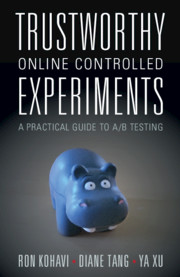Book contents
- Trustworthy Online Controlled Experiments
- Reviews
- Trustworthy Online Controlled Experiments
- Copyright page
- Contents
- Preface
- Acknowledgments
- Part I Introductory Topics for Everyone
- 1 Introduction and Motivation
- 2 Running and Analyzing Experiments
- 3 Twyman’s Law and Experimentation Trustworthiness
- 4 Experimentation Platform and Culture
- Part II Selected Topics for Everyone
- Part III Complementary and Alternative Techniques to Controlled Experiments
- Part IV Advanced Topics for Building an Experimentation Platform
- Part V Advanced Topics for Analyzing Experiments
- References
- Index
2 - Running and Analyzing Experiments
An End-to-End Example
from Part I - Introductory Topics for Everyone
Published online by Cambridge University Press: 13 March 2020
- Trustworthy Online Controlled Experiments
- Reviews
- Trustworthy Online Controlled Experiments
- Copyright page
- Contents
- Preface
- Acknowledgments
- Part I Introductory Topics for Everyone
- 1 Introduction and Motivation
- 2 Running and Analyzing Experiments
- 3 Twyman’s Law and Experimentation Trustworthiness
- 4 Experimentation Platform and Culture
- Part II Selected Topics for Everyone
- Part III Complementary and Alternative Techniques to Controlled Experiments
- Part IV Advanced Topics for Building an Experimentation Platform
- Part V Advanced Topics for Analyzing Experiments
- References
- Index
Summary
In Chapter 1, we reviewed what controlled experiments are and the importance of getting real data for decision making rather than relying on intuition. The example in this chapter explores the basic principles of designing, running, and analyzing an experiment. These principles apply to wherever software is deployed, including web servers and browsers, desktop applications, mobile applications, game consoles, assistants, and more. To keep it simple and concrete, we focus on a website optimization example. In Chapter 12, we highlight the differences when running experiments for thick clients, such as native desktop and mobile apps.
Information
- Type
- Chapter
- Information
- Trustworthy Online Controlled ExperimentsA Practical Guide to A/B Testing, pp. 26 - 38Publisher: Cambridge University PressPrint publication year: 2020
